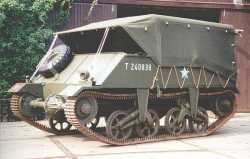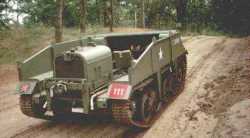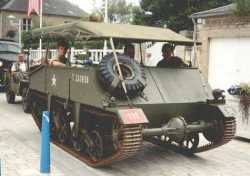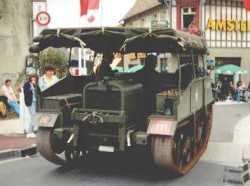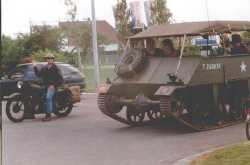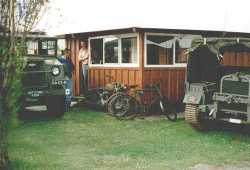| Introduction |
 THE
LOYD CARRIER owed much to the 15cwt 4x2 Fordson (Ford UK) truck from which
it borrowed the engine, radiator, gear box transmission tube and differential.
The radiator was at the rear with the drive taken to the front sprockets,
requiring the axle to be inverted and thereby reversing the direction of
the drive. The rear idlers and front sprockets both were fitted with brake
drums, steering being achieved by levers locking up one side or another
- nothing as sophisticated as track-warping here! The suspension uses the
same slow-motion, double-forked types as used on other contemporary Bren,
Scout and MG carriers, two units per side, the rear being reversed. THE
LOYD CARRIER owed much to the 15cwt 4x2 Fordson (Ford UK) truck from which
it borrowed the engine, radiator, gear box transmission tube and differential.
The radiator was at the rear with the drive taken to the front sprockets,
requiring the axle to be inverted and thereby reversing the direction of
the drive. The rear idlers and front sprockets both were fitted with brake
drums, steering being achieved by levers locking up one side or another
- nothing as sophisticated as track-warping here! The suspension uses the
same slow-motion, double-forked types as used on other contemporary Bren,
Scout and MG carriers, two units per side, the rear being reversed.
The prototype vehicle was tested by the Army in late 1939, with an initial order for 200 being placed shortly thereafter. The original role was intended to be that of personnel carrier, and the carrier was designated (in typical British style) "Carrier, Tracked, Personnel Carrying". As with all carriers it wasn't long before they were being adapted for other roles (more on this later). During the production run the carrier's external appearance changed only slightly with the addition of one or two brackets from the hull to the bogies for extra rigidity. Originally the brakes were Bendix, but later Girling Brakes were introduced and this change seems to define the MkI and MkII designation. The original carriers had British Ford 85bhp V-8 engines, but later American 90bhp V-8s and Canadian 85bhp V-8s were introduced. Originally produced by Vivian Loyd's own company, larger firms soon took over production. The mass producers were the Ford Motor Company and Wolseley Motors, who between them manufactured more than 13,000. Other manufacturers were Dennis Bros. Ltd., Aveling & Barford and the Sentinel Waggon Works. Total production is thought to have been approximately 26,000. The Loyd was of course widely used in infantry battalions for hauling 6-pdr antitank guns around as well as a 4.2in mortars. There was also a variant, "Tractor Anti-tank, MkI", which towed the 2-pdr and carried the gun crew and ammo as well (also a spare wheel for the gun). The side shields of the 2-pdr were attached to the sides of the drivers compartment as an added measure of protection. A similar Anti-tank tractor was used with the 6-pdr in both British and Canadian service (although the latter heavily favoured the Universal Mk.II*, T-16 or Windsor for that function). One of the first variants conceived was a slave battery carrier, or in Military speak, "Carrier, Tracked, Starting and Charging" (don't you just love those designations?). These were attached to armoured regiments to act as mobile charging vehicles for tank units. This required a power take-off located by the gearbox driving through universal couplings a 30-volt dynamo and a 12-volt dynamo. The slave battery unit was a 30-volt, 300 amp/hr unit and was positioned against the hull plates on both sides. Another variant was the "Carrier, Tracked, Cable Layer Mechanical", used by Royal Signals units. As regards experimental versions, there were the usual smattering of AA guns (one with quadruple brens) and self-propelled 2-pdrs etc. There was even a self-propelled 25-pdr howitzer version. |
|
|
| - primary source: British Tanks and Fighting Vehicles 1914-1945 by B.T. White, 1970, pub. by Ian Allen; text by Chris Shillito of ARMOUR IN FOCUS |
|
|
